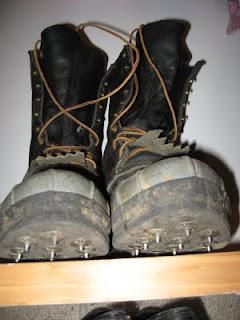Another cloudy morning dawns, and another counter-clockwise run embarking from Secret Harbor. First stop: Cypress Head. Great place to camp if you can get there. It’s connected to the main island by a TOMBOLO, the most ZAMBONI-esque of geographic terms. I paced all over looking for a site. Like middens, tombolos have plenty of shell, but it’s pretty much impossible to tell whether people had a role. Some shell and plenty of charcoal and ash on the uplands, but it’s a campsite, and nothing there to clue me into a truly old site. In good human habitat, and absent stable or growing soils, humans erase their sites.

Then on to Pelican Beach. This is where most people camp. More crowded, tents parked on the beach crest instead of dispersed in the trees. Why would anyone go here instead of Cypress Head? We rowed ashore to deliver biomass to the composting toilets (in a nature preserrve, don’t encourage people to toss in local leaves, and ignore the irony of importing bales of animal bedding).

Then the captain and I headed inland to cross the island on foot, bound for Smugglers Cove. The day before, passing the place on the water, it made no sense to me why a smuggler would choose a wide-open bight instead of the hidden fastness of Secret or Eagle Harbors. From land, though, you realize that the view from the shore is wide, and provides plenty of warning should someone be trying to sneak up on you (plus a bonus: line of sight to Eagle Cliff, where a lookout's view opens to 360). Revenuers headed toward you? Tuck into the woods and hide the goods, returning to shore to greet them empty-handed. Rare is the gummint worker that’s going to traipse through the woods and be able to track down the hooch. In Secret Harbor, by the time they rounded the bend, you were a sitting duck, which probably explains the moonshiners there resorting to the simple expedient of getting the agents drunk. Oral histories say the coast guard guys would drink for while and dump their fuel to make it seem they were on patrol. I seriously doubt that depression bootleggers would let fuel go anywhere but in their spare tanks.

The beach here has some serpentine outcrops glassy as obsidian, but there ain’t no flaking this stuff. And you probably shouldn’t try, because the same fibrous structure that thwarts knapping also demonstrates the asbestos-ness of this stone. Another threat to archaeological lungs.
So then back up over the island, but hanging a left at the top of the pass to reach Eagle Cliffs (Salish name supposedly means “Bloody Stump,” referring to the dead, red mossy balds in summer, resembling the decapitated neck of a duck). Incredible panorama from up there, especially in this nicely clarified afternoon. Eventually decided that something we were looking for would probably remain hidden, lead us on a wild (maybe headless) goose chase, drop us off a cliff, or commence an endless late-afternoon bush-whacking hike. So we opted for the shorter trek back to the trail and descent to Pelican. It felt like a long walk by then, but the whole thing couldn’t have been more than 3-4 miles with a max elevation gain of 600 feet, and the sight of retirees ascending as we neared shore put things back in perspective.
So, back down the hill and it was matter of a short row back to the boat. I’d pulled it off in the morning, and being born southern and raised Baptist [Holy Crap! MS Word auto-capitalized the denomination], macho guilt had kicked in sufficiently for me to volunteer on the afternoon row as well.

Thank Evolution that my life doesn't depend much on rowing, because that 30 meters or so was one of the most schadenfreudish shows of ineptitude I have ever performed. Disclaimer/Excuse: rowing across a swift current, two of us crammed in a 6-foot dingy so that oars constantly hit our knees, may not be the easiest pull. But I’m pretty sure it took me a half hour to get there. Gaining a little, losing a little, unable to catch enough of a rhythm to do more than break even, dislodging oarlocks. The final route, traced on a map, would be a giant question mark, the serif tip being a final desperate lunge, hand on the launch and toes hooked to the dingy.
Then the bliss of engine-powered swiftness back to Secret Harbor. No spaghetti sauce that night, so leftovers sustained us. I’d held back, and now produced the pack of cookies. I learned long ago that chewy cookies are a fine thing after a few days of fieldwork. Instead of Chewy Chips Ahoy (which taste plastic in town, but are fine for isolated shores), I’d upgraded to some northwest brand with a bold working class heroine on the package, and it turned out to be a good choice.
Then to bed, a bit sore, but feeling strong and happy, earning the rest more than I could in a few weeks of cubicle days.





















































